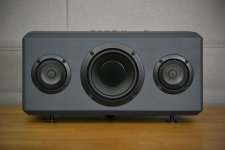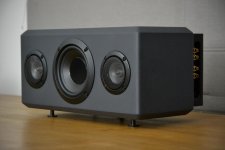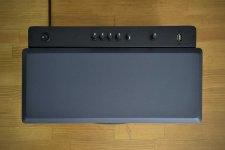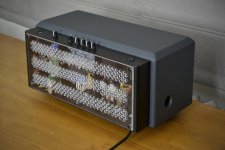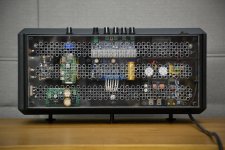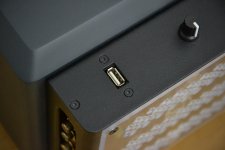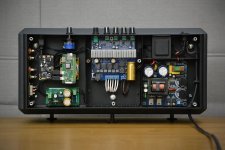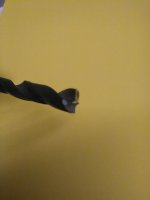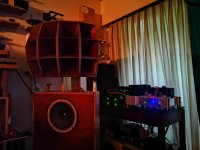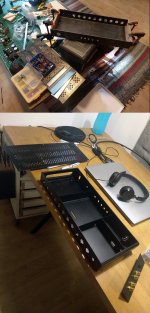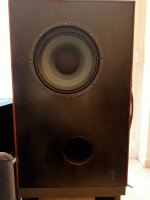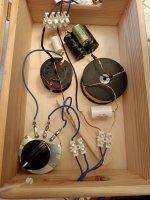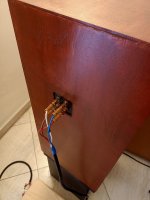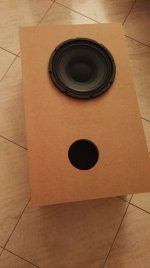JBL bookshelf speakers connected to my McIntosh MC2205, dbx 234 crossover, Krell PAM-7 preamp. Sitting in front of Klipsch Cornwall speakers.
Let's be honest, this is not exactly a budget setup, so why not put in some thick carpets, and perhaps some draping, and some ceiling absorbance? If you're going to park a car in there, you could at least line the floor with rubber tiles or something.
Just saying.
Thanks, it's in progress. I still have to figure out which amp(s) I want to connect to the bookshelf speakers and move some stuff around. There's no way my wife will let me put these speakers anywhere in the house and my kid uses the garage to practice guitar.
>"There's no way my wife will let me put these speakers anywhere in the house"
Sounds like a good "Lounge" topic; "Best known strategies to mitigate the WAF"
I'm grateful mine is based primarily on luck of the draw.
Sounds like a good "Lounge" topic; "Best known strategies to mitigate the WAF"
I'm grateful mine is based primarily on luck of the draw.
. The bass cabinets have a trick up their sleeves on the inside as well. There are baffles going going from the woofers to the walls in 45° increments. These split the bass enclosure up in multiple Chambers with no parallel walls. This results in very a complete lack of resonances and results in very well controlled bass. And because of the diverging shape of the baffles the prevent compression and enhance dynamics. Because the baffles are placed from side to side around the woofers they also make the enclosure extremely stiff from side to
Thanks for the discription, I particularly like the baffles around the bass drivers
Thanks for the discription, I particularly like the baffles around the bass drivers
2.1 speaker (boombox) with Raspberry Pi
Hi, I'm not sure that this is the right topic, but because the speaker is some kind a multiway I decided to show it here 🙂
I finished the speaker few months ago but manage to make photos before few days.
Used drivers are Visaton W 130 X and Tandband W3-871 (with notch filters). Amplifier is based on a TPA3116 with some mods. PSU is from Connexelectronic on 24V. Main source is linear powered Raspberry Pi Zero W with cheap ES9023 dac with TCXO (twice as expensive as the dac🙂). There is a separate bluetooth module with a little poor signal level 🙂
Input selector is passive little ALPS switcher.
Enclosure is made from 15mm plywood (subwoofer panel is 30mm). The back enclosure is from 2mm steel.
There were some problems with wi-fi on the Pi with steel back. Because of this I made the transparend back panel.
I drilled the holes through the metal back quickly and slightly distorted them, but probably will make a new back panel of thinner material and with straight holes 🙂
The sound is very nice 🙂
Hi, I'm not sure that this is the right topic, but because the speaker is some kind a multiway I decided to show it here 🙂
I finished the speaker few months ago but manage to make photos before few days.
Used drivers are Visaton W 130 X and Tandband W3-871 (with notch filters). Amplifier is based on a TPA3116 with some mods. PSU is from Connexelectronic on 24V. Main source is linear powered Raspberry Pi Zero W with cheap ES9023 dac with TCXO (twice as expensive as the dac🙂). There is a separate bluetooth module with a little poor signal level 🙂
Input selector is passive little ALPS switcher.
Enclosure is made from 15mm plywood (subwoofer panel is 30mm). The back enclosure is from 2mm steel.
There were some problems with wi-fi on the Pi with steel back. Because of this I made the transparend back panel.
I drilled the holes through the metal back quickly and slightly distorted them, but probably will make a new back panel of thinner material and with straight holes 🙂
The sound is very nice 🙂
Attachments
Last edited:
I'm old school; I sharpen drills, taps and dies, modify them and all sorts. Once a work colleague noticed that I'd done some thread cutting ( a left handed grub screw was required as an emergency repair ) and said " oh, I didn't know you had thread cutting tips ", I just laughed and said " No, I just sharpened a bit of high speed steel !". I'd never throw HSS away, old hacksaw blades can be well useful.
£ 10.00p can buy a CD or a couple of MKPs, plus I can have one in five minutes and save a trip to the shops.
Make do and mend! You young 'uns today!
£ 10.00p can buy a CD or a couple of MKPs, plus I can have one in five minutes and save a trip to the shops.
Make do and mend! You young 'uns today!
Last edited:
I've tried sharpening a drill bit with a file, but it dulled very quickly after that. The hardware shop is 2 minutes away, and a bit costs me less than £2.
In another thread, perhaps another time, if it comes up, I wouldn't mind discussing tooling tips.
In another thread, perhaps another time, if it comes up, I wouldn't mind discussing tooling tips.
Trying to sharpen a drill with a file, both designed to be hard cutting tools!
I agree about sharpening drills, and am amazed at just how many people will just buy a new one rather than re-sharpen. With practice a better result can be obtained than is provided by a new one.
I agree about sharpening drills, and am amazed at just how many people will just buy a new one rather than re-sharpen. With practice a better result can be obtained than is provided by a new one.
Tubes are back,
And so are the high efficiency horns!
Actively crossed at 125 Hertz 4th order, and the horns are used as helper tweeters, to see if there's a noticeable improvement by not using a series inductor on that 12" full ranger.
It does.
The subs are in, since these are dipole horn hybrids, but with a tube amp, they're not really necessary.
A little better, when level matched properly, but welcome with movies.
And so are the high efficiency horns!
Actively crossed at 125 Hertz 4th order, and the horns are used as helper tweeters, to see if there's a noticeable improvement by not using a series inductor on that 12" full ranger.
It does.
The subs are in, since these are dipole horn hybrids, but with a tube amp, they're not really necessary.
A little better, when level matched properly, but welcome with movies.
Attachments
View attachment 880196
View attachment 880197
Try sharpening your drill like this ( takes a bit of practice ). How did you get that finish?
I have such drills for wood. If you mean for the holes on the back, I used the original back as a template to drill them second time on the new transparent back (about 800 and more holes in total
 ) and because of this used drill for steel. Thanks for the information!
) and because of this used drill for steel. Thanks for the information!For the finish I used car bumper spray paint.
The exterior surfaces on the back section (for the electronics) is coated with black texture paint and the plywood enclosure is coated with anthracite matte paint (RAL7016), also for car bumpers.
Here is the "original" steel back.
Attachments
Coaxial bass reflex with Eminence speakers
Hi all, this is my first loudpeaker project. Coaxial bass reflex with Beta10CX and ASD1001. 68 litres cabinet tuned at 40 Hz, 94 - 96 dB efficiency.
The crossover is the standard Eminence 2500 CX with an LPAD on the compression driver and 1450 uF before the low pass section.
The ASD1001 will be probably substituted by a Beyma CD-11Fe/S.
Danilo
Hi all, this is my first loudpeaker project. Coaxial bass reflex with Beta10CX and ASD1001. 68 litres cabinet tuned at 40 Hz, 94 - 96 dB efficiency.
The crossover is the standard Eminence 2500 CX with an LPAD on the compression driver and 1450 uF before the low pass section.
The ASD1001 will be probably substituted by a Beyma CD-11Fe/S.
Danilo
Attachments
The sound is very clean, enough bass, high a little bit on the bright side and wonderful voices.
A very strong sense of reality.
I'm using a GM70 single ended at the moment. 25 W that are more than enough. I've tried with a EL84 single ended, 3 W, and had no problem even with high dynamic music.
Danilo
A very strong sense of reality.
I'm using a GM70 single ended at the moment. 25 W that are more than enough. I've tried with a EL84 single ended, 3 W, and had no problem even with high dynamic music.
Danilo
Hi all, this is my first loudpeaker project. Coaxial bass reflex with Beta10CX and ASD1001. 68 litres cabinet tuned at 40 Hz, 94 - 96 dB efficiency.
The crossover is the standard Eminence 2500 CX with an LPAD on the compression driver and 1450 uF before the low pass section.
The ASD1001 will be probably substituted by a Beyma CD-11Fe/S.
Danilo
When I use those terminal blocks I twist the wires together and stick them in the same hole then tighten the screw, so the terminal block is used to keep them twisted together and stops them from touching each other. I don't know if it really makes a difference, twisting wires together seems to make a good contact. Nice speaker and a good finish on the front baffle.
Hi all, this is my first loudpeaker project. Coaxial bass reflex with Beta10CX and ASD1001. 68 litres cabinet tuned at 40 Hz, 94 - 96 dB efficiency.
The crossover is the standard Eminence 2500 CX with an LPAD on the compression driver and 1450 uF before the low pass section.
The ASD1001 will be probably substituted by a Beyma CD-11Fe/S.
Danilo
Nice one. Do you have a separate thread for the build process maybe? I’m in the process of testing the same drivers in a smaller cabinet and also other HF drivers.
I share your view that the sound is very clear and enjoyable.
The case is made of 19mm thick MDF, cutted on a CNC machine by a professional carpenter. The design was made using Unibox and other two speaker design software, in order to verify the result.
The internal edges are finished with liquid rubber.
The speaker is damped on each wall except the front one. There are three different damping materials: wedge moulded foam for the side walls and the rear wall (two different tickness), glass wool on top and bottom.
The external finish is made with 4mm plywood on top rear and side walls, black painting for the front baffle, and varnish for wood for the plywood.
Attached are two images of the speaker before the finish, one at the middle of the building process, the other during a listening session with the first prototype of the crossover.
Danilo
The internal edges are finished with liquid rubber.
The speaker is damped on each wall except the front one. There are three different damping materials: wedge moulded foam for the side walls and the rear wall (two different tickness), glass wool on top and bottom.
The external finish is made with 4mm plywood on top rear and side walls, black painting for the front baffle, and varnish for wood for the plywood.
Attached are two images of the speaker before the finish, one at the middle of the building process, the other during a listening session with the first prototype of the crossover.
Danilo
Attachments
- Home
- Loudspeakers
- Multi-Way
- System Pictures & Description
